The Perfect Martial Arts Curriculum
/In the traditions of India, Japan and China, it is common to teach using an ideal model. Copy the model and practice like crazy and eventually you will understand how the model was created, both what makes it tick and what raw materials went into it. "Reverse engineering" is the name techies give for this type of teaching. It works well in flexible one-on-one learning situations where, if for some reason, a particular model isn't coming together, the master teacher can just change to a different model.
This way of transmitting cultural knowledge tends to be quite effective at creating continuity. It's weakness lays in it's tendency to "worshiping" the model itself. If the teacher believes a particular model is so great it should never be changed he will tend to blame the student (or the society as a whole) for artistic decline. It's also possible that the teacher got an imperfect transmission of the model and ends up transmitting superficial knowledge.
Western Civilization gives priority in learning to cognitive understanding, not models. Even when faced with an art which is visceral and corporeal, the tendency is to teach with a curriculum utilizing progressive stages of conceptualization.
This type of teaching tends to make efficient use of time and facilitates group learning. It's very adaptable. If the students aren't getting it, the teacher will try to develop a new lesson based on the notion that all knowledge is built on previous knowledge. By working with the pieces, eventually the whole picture will come into view.
Working against this approach is the problem that acquired knowledge based on conceptual notions or utilitarian routines can sometimes inhibit artistic realms of awareness. (That's what the film the Black Swan is about, by the way.) Artistic skills and ability are not always based on previous knowledge. Realms of awareness which open up possibilities of spontaneous action can not really be taught, they must be discovered. In fact, one type of knowledge can inhibit learning in another realm, like hitting the brake and the gas at the same time.
Too often the role of teacher as facilitator is undervalued and the role of teacher as "spoon feeder" is idealized. My own learning experience in the martial arts benefited enormously from the "just copy this ideal model" and practice like crazy way of doing things. Getting autonomous students to willingly submit to that form of learning usually requires a huge head fake. A sort of matador's cape that I've never been particularly good at wielding. Meanwhile our society exerts an enormous amount of pressure on teachers to create a progressive curriculum.
_____________________________________
All of that was just a conceptual prelude to me presenting the problem in the following practical terms.
If you want to understand the value of strength, do some really hard physical labor for an extended period of time. Try working 20 hour days commercial fishing in Alaska, carrying around 80 pounds of gear all day above 10,000 feet, or tossing bales of hay in Iowa. (Perhaps people can mimic some of these effects in the gym, but I'm skeptical.) Once you have this kind of strength you will appreciate flexibility as a total revelation. Without first developing this kind of strength, flexibility just seems like a convenience. But build up some serious strength and flexibility will seem like a treasure.
Once you have strength and flexibility, structure is a revelation. Good or correct structure will allow you to transfer force through your bones, dramatically reducing the need for muscular strength, allowing you to conserve enormous amounts of energy.
Once you have structure you can develop it so that any movement at any angle or curve has integrity. And then looseness will be revelation. With looseness you will have the ability to have structure only when you want it. You can disappear and re-appear at will.
Once you have looseness, momentum is a revelation. Looseness will give you the speed and adaptability to take advantage of both your own and an opponent's momentum. It's a whole different way of fighting. (Yes, I'm talking about fighting again, but it's only a frame for the larger philosophical discovery.)
Once you understand momentum, you will feel the value of increasing the unified integrity of your entire liquid mass as a revelation. Unity comes about through reducing all effort. Eventually you will experience turning off all specific muscular control as a revelation.
Once you have discarded effort, emptiness becomes a revelation. Emptiness connects the effortless body to spacial awareness.
No doubt there are revelations to come.
Laozi says that the more focused, differentiated, specific and clear an idea becomes, the more likely it is to begin to stagnate and decay or harden and break. Shouldn't this be the first lesson?

 I really don't know what to do. Paulie Zink has
I really don't know what to do. Paulie Zink has  It is a staple of Chinese movement and religious studies that the tongue should be on the roof of the mouth. In Daoist ritual and ritual meditation the tip of the tongue is sometimes used to draw talisman on the roof of the mouth. But in Zouwang (sitting and forgetting) the basic emptiness meditation practice, which is very much like Zen, part of the posture instructions for stillness include putting the tip of the tongue on the roof of the mouth behind the teeth. I’ve also heard people say to put the tongue on the soft pallet. The identical instruction is standard in Tai Chi and other internal martial arts and qigong classes.
It is a staple of Chinese movement and religious studies that the tongue should be on the roof of the mouth. In Daoist ritual and ritual meditation the tip of the tongue is sometimes used to draw talisman on the roof of the mouth. But in Zouwang (sitting and forgetting) the basic emptiness meditation practice, which is very much like Zen, part of the posture instructions for stillness include putting the tip of the tongue on the roof of the mouth behind the teeth. I’ve also heard people say to put the tongue on the soft pallet. The identical instruction is standard in Tai Chi and other internal martial arts and qigong classes.
 They say we use only a small portion of our brain, and that of the small part we do use, about
They say we use only a small portion of our brain, and that of the small part we do use, about 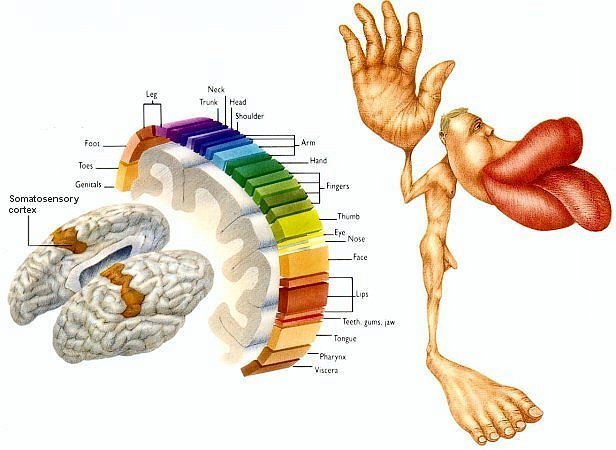
 Here is the info on a
Here is the info on a  He credits his ability to years of train in the Daoyin system which he learned along with the Monkey Kungfu. This system is a combination of meditation techniques, some of them very old and shamanic like spending 4 hours balancing on only your knees and elbows staring at a flame, along with balancing, stretching, folding, rolling, exploding, pounding and scrapping. It is made up of animal imitation. Each animal has a whole series of meditations, postures, and forms of locomotion. It is the forms of locomotion that really sets it apart from a yoga class, but around half of the postures are quite similar to yoga postures. The difference is, his frog eats flies and hops, his bunny wiggles it's tail, and his downward-dog, scampers around the room and tries to lick people.
He credits his ability to years of train in the Daoyin system which he learned along with the Monkey Kungfu. This system is a combination of meditation techniques, some of them very old and shamanic like spending 4 hours balancing on only your knees and elbows staring at a flame, along with balancing, stretching, folding, rolling, exploding, pounding and scrapping. It is made up of animal imitation. Each animal has a whole series of meditations, postures, and forms of locomotion. It is the forms of locomotion that really sets it apart from a yoga class, but around half of the postures are quite similar to yoga postures. The difference is, his frog eats flies and hops, his bunny wiggles it's tail, and his downward-dog, scampers around the room and tries to lick people.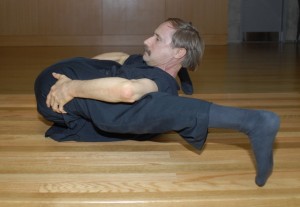
 A 9 year old student asked me during class the other day if I did any strength training. I did my teacher thing and screwed up one side of my face while bulging out my eye on the other, "No," I replied, "Do you do any strength training?" This kid admitted that he didn't but I could see by the way he looked at the ground that someone had been trying to breed a feeling of deficiency in this kid's head. Now we aren't talking about just any old 9 year old, this kid can walk across the room on his hands and he can do a press handstand from a straddle position on the floor. So I said, "OK, you stand in a low horse stance and I'll put all my weight on your shoulders and you try to lift me up." I leaned down on his shoulders and lifted myself up on to the very tips of my toes so that he had about 150lbs on his shoulders. He then stood up with out even a second thought, lifting me into the air. "That was easy right?" I asked. "You could lift two adults couldn't you?." "Yeah," he said, looking a little brighter. "So you're strong enough already right?" He just looked at me, unsure what to say. "Now you have to figure out how to transfer the force of your legs to your arms. That's what you need to work on." And then we got back to the two-man form we had been working on when he asked the question.
A 9 year old student asked me during class the other day if I did any strength training. I did my teacher thing and screwed up one side of my face while bulging out my eye on the other, "No," I replied, "Do you do any strength training?" This kid admitted that he didn't but I could see by the way he looked at the ground that someone had been trying to breed a feeling of deficiency in this kid's head. Now we aren't talking about just any old 9 year old, this kid can walk across the room on his hands and he can do a press handstand from a straddle position on the floor. So I said, "OK, you stand in a low horse stance and I'll put all my weight on your shoulders and you try to lift me up." I leaned down on his shoulders and lifted myself up on to the very tips of my toes so that he had about 150lbs on his shoulders. He then stood up with out even a second thought, lifting me into the air. "That was easy right?" I asked. "You could lift two adults couldn't you?." "Yeah," he said, looking a little brighter. "So you're strong enough already right?" He just looked at me, unsure what to say. "Now you have to figure out how to transfer the force of your legs to your arms. That's what you need to work on." And then we got back to the two-man form we had been working on when he asked the question.
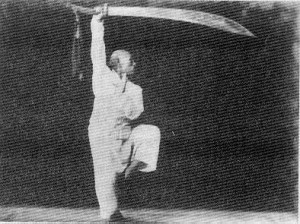 And don't get me started on core strength.... OK, it's too late. Core strength is just a marketing scheme, like Green architectural-design-dog-walking-nanny services. It just sounds good or something. It plays on peoples feelings of insecurity and guilt. There is no core that needs strengthening to begin with, but even if such a core existed, the market is saturated. Every type of movement training from Yoga to tiny-tot-tap-dancing now claims to be good for your "core."
And don't get me started on core strength.... OK, it's too late. Core strength is just a marketing scheme, like Green architectural-design-dog-walking-nanny services. It just sounds good or something. It plays on peoples feelings of insecurity and guilt. There is no core that needs strengthening to begin with, but even if such a core existed, the market is saturated. Every type of movement training from Yoga to tiny-tot-tap-dancing now claims to be good for your "core." September being Yoga Month, I happened on an article yesterday in Common Ground called, "Should You Sleep With Your Yoga Teacher." It's hardly worth linking too...and sorry it's not on-line yet. In a few words; it was wishy-washy. The majority of Yoga teachers quoted the precept, "Do no harm." Which is of course a fantasy, not a precept. But it makes an interesting contrast with the Martial Arts precept, "Do maximum harm."
September being Yoga Month, I happened on an article yesterday in Common Ground called, "Should You Sleep With Your Yoga Teacher." It's hardly worth linking too...and sorry it's not on-line yet. In a few words; it was wishy-washy. The majority of Yoga teachers quoted the precept, "Do no harm." Which is of course a fantasy, not a precept. But it makes an interesting contrast with the Martial Arts precept, "Do maximum harm."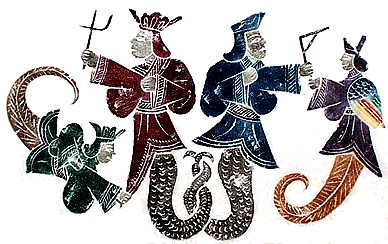 I’ve been working with the “ball” material I wrote about in the last post and I’ve decided that there is an other way to explain it.
I’ve been working with the “ball” material I wrote about in the last post and I’ve decided that there is an other way to explain it.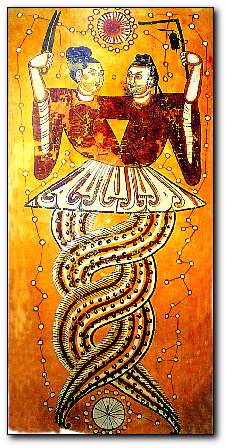 I used the term autonomic above. The nervous system is divided into two types of nerves, the ones that control obviously voluntary actions (yes that would include ear wiggling even if you aren’t very good at it yet); and nerves that control much less voluntary things like pupil size and heart rate. The less voluntary system is called the autonomic nervous system and it is also divided into two parts. One part that is active when you take a deep relaxing breath while sitting in a hot tub, and another part that is active when you hold your breath, tense up your muscles, pull back your lips and grit your teeth. The relaxing nervous system is called para-sympathetic, the stressed out nervous system is called sympathetic. (I know the names are ridiculous, they refer to anatomy you only see when you are doing a dissections.)
I used the term autonomic above. The nervous system is divided into two types of nerves, the ones that control obviously voluntary actions (yes that would include ear wiggling even if you aren’t very good at it yet); and nerves that control much less voluntary things like pupil size and heart rate. The less voluntary system is called the autonomic nervous system and it is also divided into two parts. One part that is active when you take a deep relaxing breath while sitting in a hot tub, and another part that is active when you hold your breath, tense up your muscles, pull back your lips and grit your teeth. The relaxing nervous system is called para-sympathetic, the stressed out nervous system is called sympathetic. (I know the names are ridiculous, they refer to anatomy you only see when you are doing a dissections.)